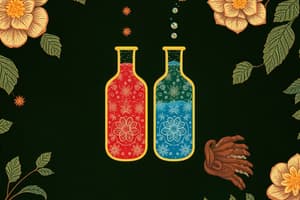Podcast
Questions and Answers
Which of the following substances is likely to turn blue litmus paper red?
Which of the following substances is likely to turn blue litmus paper red?
- Olive oil
- Baking soda solution
- Sugar water
- Lemon juice (correct)
Which of these items can be safely used to test for acidity and basicity at home?
Which of these items can be safely used to test for acidity and basicity at home?
- Vinegar (correct)
- Bleach
- Soda
- Dish soap (correct)
What safety equipment should be used when handling acids and bases in a school lab?
What safety equipment should be used when handling acids and bases in a school lab?
- Safety glasses and gloves (correct)
- Face shield only
- Open-toed shoes
- Ear plugs
When testing a solution with a litmus indicator, what characteristic of the indicator indicates the presence of a base?
When testing a solution with a litmus indicator, what characteristic of the indicator indicates the presence of a base?
Which of the following demonstrates improper handling of science equipment?
Which of the following demonstrates improper handling of science equipment?
Study Notes
Identifying Solutions
- Acids, bases, and salts can be found in common household and school items, including food, cleaning products, and laboratory substances.
- Litmus indicators change color in response to pH levels:
- Acids turn blue litmus paper red.
- Bases turn red litmus paper blue.
- Neutral solutions do not change the color of either litmus paper.
- Common examples of acids include vinegar (acetic acid) and lemon juice (citric acid).
- Common examples of bases include baking soda (sodium bicarbonate) and soap.
- Common examples of salts include table salt (sodium chloride) and Epsom salt (magnesium sulfate).
Use and Handling of Science Equipment
- Proper use of science equipment ensures safety and accuracy during experiments.
- Always wear appropriate personal protective equipment (PPE) such as gloves and goggles when handling chemicals.
- Familiarize with basic lab equipment:
- Test tubes and holders for mixing and observing reactions.
- Beakers and flasks for measuring and storing liquids.
- Bunsen burners for heating substances.
- Understand the correct procedures for using indicators, such as adding a few drops of litmus to the solution to observe color changes.
- Follow lab protocols for disposal of chemicals to prevent contamination or accidents.
Studying That Suits You
Use AI to generate personalized quizzes and flashcards to suit your learning preferences.
Description
This quiz explores the fundamental concepts of acids, bases, and salts, focusing on their presence in everyday items. You will learn about pH levels, litmus indicators, and common examples of these substances found in households and schools.




